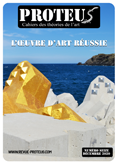L’œuvre d’art entre « perfection » et « réussite ». Remarques sur la terminologie esthétique d’Adorno
Abstract
 Télécharger l’article
Télécharger l’article
Paru dans : Proteus n°16

Pour bien comprendre le sens et la fonction que dans la théorie esthétique d’Adorno a la notion de « réussite » de l’œuvre d’art, il faut d’abord éviter de la réduire à un quelque « idéal classique de perfection ». C’est pour cela qu’en revanche il est important de démontrer la relation qui lie la notion de « réussite » à celle de « forme » qui, chez Adorno, perd ses traits idéalistes et abstraits ; telle qu’Adorno l’utilise, celle-ci est plutôt un concept opérationnel qui sert à la fois à décrire l’œuvre d’art en tant qu’articulation » cohérente et logique des matériaux et à l’interpréter en tant que produit « formé » dans le cadre du devenir historique.
Mots-clés : Adorno — Crise de l'apparence — Classicité — Contenu de vérité — Antinomie
In order to understand the meaning and the function of the idea of artwork’s “achievement” in Adorno’s aesthetic theory, it is necessary to avoid identifying it with the “classical idea of perfection”. That is why it will be important to demonstrate, on the contrary, the connection between the idea of “achievement” and that of “form” which, in Adorno’s aesthetics, loses its idealistic and abstract features; according to Adorno, “form” is rather an operational concept for describing the artwork’s constructive and logical coherence (that is to say, its “articulation”) and, at the same time, for interpreting it as a “formed” product in the context of historical development.
Keywords: Adorno — Crisis of Appearance — Classicity — Truth Content — Antinomy








